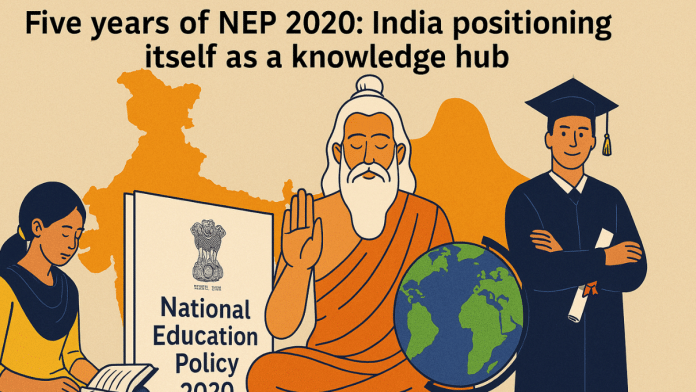Thank you dear subscribers, we are overwhelmed with your response.
Your Turn is a unique section from ThePrint featuring points of view from its subscribers. If you are a subscriber, have a point of view, please send it to us. If not, do subscribe here: https://theprint.in/subscribe/
On 29 July 2025, India marks five transformative years since the adoption of the National Education Policy (NEP) 2020—a vision that goes beyond administrative reform. It seeks to reshape the very soul of Indian education by fusing civilisational values with global aspirations. Across the country, educational institutions are not merely observing a policy milestone; they are participating in a renaissance. A renaissance rooted in the idea of India as Vishwaguru—a global beacon of wisdom.
NEP 2020 does not draw false binaries between ancient and modern, between Nalanda and Harvard. Instead, it proposes a confident synthesis—international standards blended with Indic depth, offering an educational model that is both globally competent and spiritually grounded. This is not imitation. It is innovation with identity.
Global Campuses, Indian Soil
One of NEP 2020’s most visible breakthroughs has been the facilitation of foreign universities setting up campuses in India. Long discussed, this initiative has found practical shape through regulatory clarity provided by the University Grants Commission. Institutions like the University of York, University of Western Australia, and Illinois Institute of Technology are now in the process of establishing an Indian presence.
This is not mere symbolism. It signifies India’s rising stature as a co-creator in global academia. Indian students now have access to world-class faculty and curricula without needing to leave their homeland. And global academia discovers India not as a passive recipient, but as an active node in knowledge exchange. Education is no longer a one-way pipeline—it becomes a vibrant platform.
From Brain Drain to Brain Gain
For decades, India has watched its brightest minds migrate abroad. NEP 2020 addresses this systematically through twinning programmes, internationally recognised joint degrees, and credit transfer protocols—mechanisms that offer global exposure while retaining institutional grounding in India. Meanwhile, the ‘Study in India’ initiative is gaining traction. Students from Asia, Africa, and Latin America are enrolling in Indian universities drawn by academic quality, affordability, and cultural richness. Streamlined visa processes, scholarships, and English-medium instruction add to this appeal.
India is thus evolving from a talent-exporting nation to a knowledge destination—attracting and retaining global minds.
Reclaiming Indian Knowledge Systems
NEP 2020 makes a decisive civilisational turn by mainstreaming Indian Knowledge Systems (IKS). Once confined to niche studies, fields like Ayurveda, Nyaya logic, Vedic mathematics, temple architecture, and classical literature are finding place in mainstream curricula.
This is not cultural nostalgia but academic parity. With support from the IKS Division of the Ministry of Education, universities are developing syllabi, training faculty, and funding research rooted in Indian epistemologies. Students now learn Panini’s grammar alongside Chomsky’s, or Kautilya’s statecraft next to modern economics.
Such integration affirms that India’s intellectual traditions are not alternatives but complements to global canons.
Language as Inclusion
NEP 2020 recognises that access to knowledge must not be restricted by language. It promotes a multilingual ecosystem where Indian languages are vehicles of higher learning, not obstacles.
Today, engineering, commerce, and social science courses are being taught in Hindi, Tamil, Bengali, and other regional languages. Translation cells, bilingual textbooks, and regional academic journals are bridging the linguistic divide. This is especially empowering for rural and first-generation learners, enabling cognitive growth in the mother tongue while preserving linguistic diversity.
Research from the Grassroots Up
NEP 2020 democratizes research by institutionalising it beyond elite spaces. It envisions the National Research Foundation (NRF) to fund and mentor projects across disciplines and institutions. Simultaneously, Research & Development Cells (RDCs) have been established in thousands of Higher Education Institutions (HEIs).
From sustainable agriculture in tribal belts to digitisation of palm-leaf manuscripts in classical departments, research is becoming “glocal”—locally anchored, globally meaningful. Every college is now a potential site of innovation. Every district, a potential contributor to the knowledge economy.
Education as Soft Power
India’s moral vocabulary—of dharma, seva, satyam, ahimsa—has long been its contribution to the world. NEP 2020 recognises that education can become the carrier of this civilisational voice.
Value-based learning, civic education, and Global Citizenship Education (GCED) modules are being embedded across disciplines. NEP’s graduate is not only skilled but self-aware; not only competitive but compassionate. This ethical underpinning makes Indian education uniquely relevant in an age of AI, alienation, and ecological breakdown.
A Civilisational Horizon
The dream of India as Vishwaguru is no longer rhetorical. Through NEP 2020, it is becoming tangible. This is not about cultural assertion—it is about intellectual dialogue. It seeks neither dominance nor dependency. It offers rooted authenticity in a world of anxious imitation.
Five years into its journey, NEP 2020 is no longer a vision on paper. It is being lived—in classrooms, research labs, administrative frameworks, and most importantly, in the aspirations of young Indians. The world is watching not just India’s economic growth, but its educational awakening. The centre of global education is shifting—and it is moving East, toward a nation finally thinking in its own voice.
These pieces are being published as they have been received – they have not been edited/fact-checked by ThePrint.


